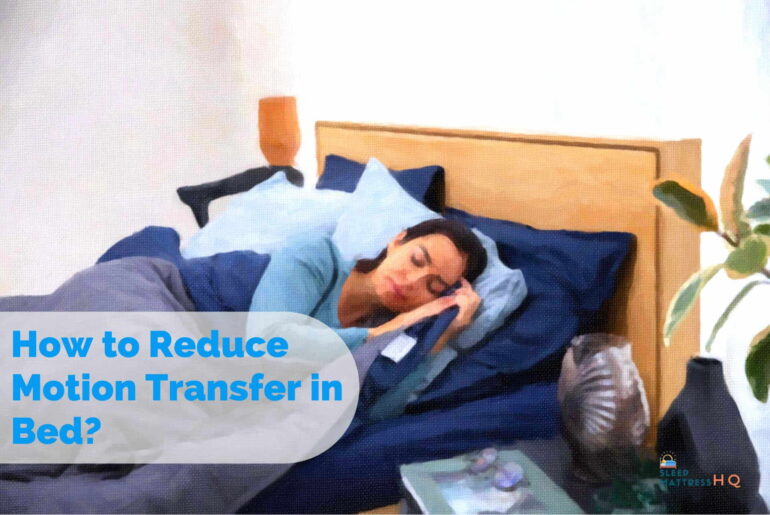Are you tired of waking up to your partner’s slight movement?
We can’t tell our partner that he or she tosses and turns too much at night. It is beyond their control.
It is time to sleep better and implement a real solution suggested by a certified sleep expert. A solution that works without changing your partner’s sleeping style.
We will explore two scenarios where you can reduce motion transfer in your existing bed as well as a scenario where you plan to buy an upgraded bed and/or mattress.
In both cases, the whole idea is to pad the sleeping surface as efficiently as possible from the core of the mattress and bed.
5 Proven Ways to Reduce Motion Transfer
Add a Mattress Topper:
This is the most common advice but it is effective only if you know what kind of mattress topper suits your needs. So read on.
The motion isolation with the mattress topper will work only if your bed frame or foundation is not adding to the problem. If your bed foundation or springs are noisy, don’t invest in a mattress topper.
It won’t help.
Motion transfer can be reduced with a topper if your mattress type, such as a spring mattress, is an issue.
Choose a topper made of memory foam or latex which has a thickness of at least two inches. These materials are best for absorbing motion in the bed.
Type of Mattress Material
Things get tricky if adding a topper doesn’t work in your favor. You will have to switch to a new mattress. And you will have to select a mattress well-suited to your main needs.
Opt for a mattress with a comfort layer of memory foam or latex. Both these materials absorb movement very well.
Avoid buying an innerspring or pocketed coil mattress. I know that for some sleepers, the bounce is a must and they don’t like the feel of foam-based mattresses But you will have to pick looking at the overall comfort.
Many websites recommend individually wrapped pocket coil beds as they are supposedly good at isolating the motion. But practically speaking the difference is not as big as you are expecting.
Hybrid mattresses are very popular and they are well-suited to most sleepers. But check out the core of the mattress and the thickness of the comfort layers. To properly isolate the motion, you need to be padded well from the base of the mattress.
Split King Mattress
Split king mattresses have become popular and are one of my top recommendations for a variety of reasons.
They are easy to move around in the house and couples can pick up two mattress types (two twin mattresses) for the same bed. This rules out the option of sleeping separately without compromising on comfort.
Adjustable Beds
Adjustable beds provide stylish and luxurious sleep for couples. These beds have the benefit of split beds with added features like the anti-snore option, relief from backaches, massage, etc including the perfect solution for motion isolation.
They are no longer comparable to those boring hospital beds.
Bed Foundation and Distance in Slats
Bed foundation as the name suggests is a foundation for bed and good sleep. So choosing a sturdy and stable bed frame is a prerequisite.
If you are bed has wooden slats, they should be strong and appropriately distanced. Improper distance will not only void your mattress warranty but also affect the mattress’s stability when you move on the bed.
What is a Motion Transfer and Why it happens?
Motion transfer in a mattress refers to the movement or vibrations that travel from one side of the bed to the other when one person moves, shifts, or gets in and out of bed.
This creates a ripple effect that can disturb your sleep partner, causing them to feel the motion and possibly wake up or be disturbed from their sleep.
Light sleepers are more prone sleep disturbance due to motion transfer.
There are several factors that contribute to motion transfer:
1. Mattress Material: The type of material used in the mattress plays a significant role. Innerspring mattresses with interconnected coils can amplify motion due to the interconnectedness of the springs. Memory foam mattresses, on the other hand, absorb and isolate motion better.
2. Coil Design: Innerspring mattresses with individually wrapped coils tend to reduce motion transfer slightly compared to those with interconnected coils, as each coil can move independently.
3. Firmness: Firmer mattresses may transmit less motion compared to softer ones, as they offer better support and reduce the sinking feeling that can lead to more motion transfer.
4. Partner Movements: Some people toss, turn, get in and out of bed, or change sleeping positions frequently throughout the night and generate more motion transfer.
5. Bed Base: The type of bed base or foundation or worn-out base impacts motion transfer. A solid platform or adjustable bed base may provide better stability and eliminate vibrations.
6. Mattress Size: A larger mattress, such as a king or queen size, can help mitigate motion transfer since there’s more space for each sleeper to move without affecting the others.
7. Body Weight: Heavy individuals may generate more motion due to the higher energy created by movements.

